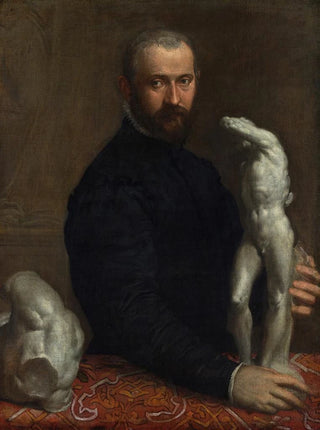Art print | Alessandro Vittoria - Paolo Véronèse


View from behind

Frame (optional)
Alessandro Vittoria - Paolo Véronèse Art print – Engaging introduction
The artwork "Alessandro Vittoria - Paolo Véronèse" is part of a captivating dialogue between sculpture and painting, where Italian Renaissance art finds a unique echo. This piece, which showcases Vittoria's virtuosity, highlights the timeless beauty of human figures while paying tribute to one of the great masters of painting, Paolo Véronèse. The encounter between these two artists, although never physically realized, materializes here in a work that exudes elegance and sophistication. Immersing oneself in this creation invites the viewer to explore the subtleties of an art that transcends eras and styles, revealing the richness of a deeply rooted artistic tradition.
Style and uniqueness of the work
The work stands out for its unique approach to human representation, where every detail is carefully crafted to evoke emotion. The mastery of light and shadow, characteristic of Véronèse's style, is present here, giving the sculpture an almost lifelike dimension. The drapery, meticulously carved, appears to float lightly, while the expressions of the figures capture moments of grace and contemplation. By incorporating typical elements of Véronèse's painting, Vittoria succeeds in creating a piece that dialogues with the past while asserting its own identity. This fusion of arts, where sculpture becomes a reflection of painting, offers a novel visual experience, allowing the viewer to appreciate the depth and complexity of Renaissance art.
The artist and his influence
Alessandro Vittoria, a renowned 16th-century sculptor, established himself as one of the leading figures of Italian Renaissance. His work is marked by a constant pursuit of formal perfection, but also by a desire to explore human emotions through stone. Influenced by his contemporaries, including Michelangelo and Titian, Vittoria developed a style that is uniquely his own, combining the rigor of sculpture with the fluidity of forms. His influence extends well beyond his era, inspiring many artists who sought to capture beauty and harmony in

Matte finish

View from behind

Frame (optional)
Alessandro Vittoria - Paolo Véronèse Art print – Engaging introduction
The artwork "Alessandro Vittoria - Paolo Véronèse" is part of a captivating dialogue between sculpture and painting, where Italian Renaissance art finds a unique echo. This piece, which showcases Vittoria's virtuosity, highlights the timeless beauty of human figures while paying tribute to one of the great masters of painting, Paolo Véronèse. The encounter between these two artists, although never physically realized, materializes here in a work that exudes elegance and sophistication. Immersing oneself in this creation invites the viewer to explore the subtleties of an art that transcends eras and styles, revealing the richness of a deeply rooted artistic tradition.
Style and uniqueness of the work
The work stands out for its unique approach to human representation, where every detail is carefully crafted to evoke emotion. The mastery of light and shadow, characteristic of Véronèse's style, is present here, giving the sculpture an almost lifelike dimension. The drapery, meticulously carved, appears to float lightly, while the expressions of the figures capture moments of grace and contemplation. By incorporating typical elements of Véronèse's painting, Vittoria succeeds in creating a piece that dialogues with the past while asserting its own identity. This fusion of arts, where sculpture becomes a reflection of painting, offers a novel visual experience, allowing the viewer to appreciate the depth and complexity of Renaissance art.
The artist and his influence
Alessandro Vittoria, a renowned 16th-century sculptor, established himself as one of the leading figures of Italian Renaissance. His work is marked by a constant pursuit of formal perfection, but also by a desire to explore human emotions through stone. Influenced by his contemporaries, including Michelangelo and Titian, Vittoria developed a style that is uniquely his own, combining the rigor of sculpture with the fluidity of forms. His influence extends well beyond his era, inspiring many artists who sought to capture beauty and harmony in






